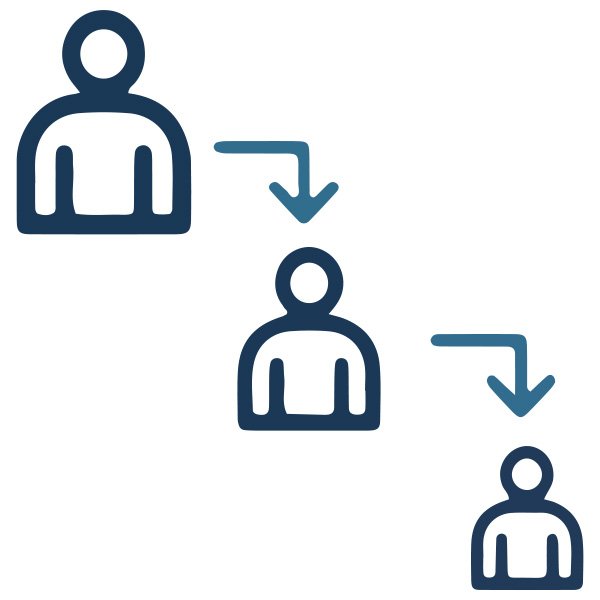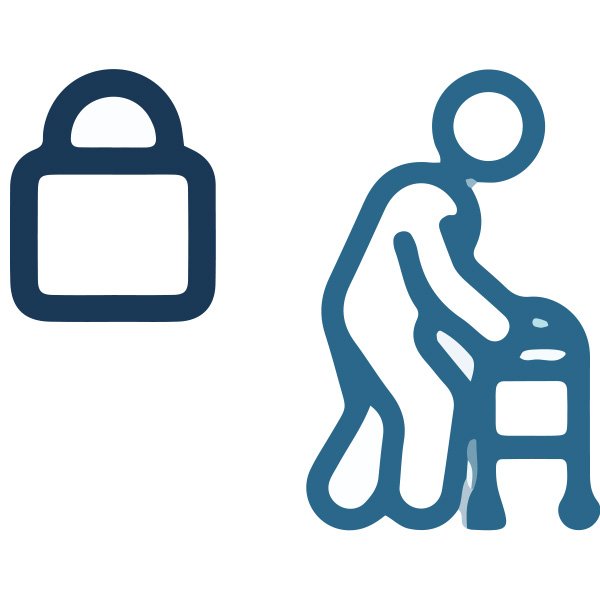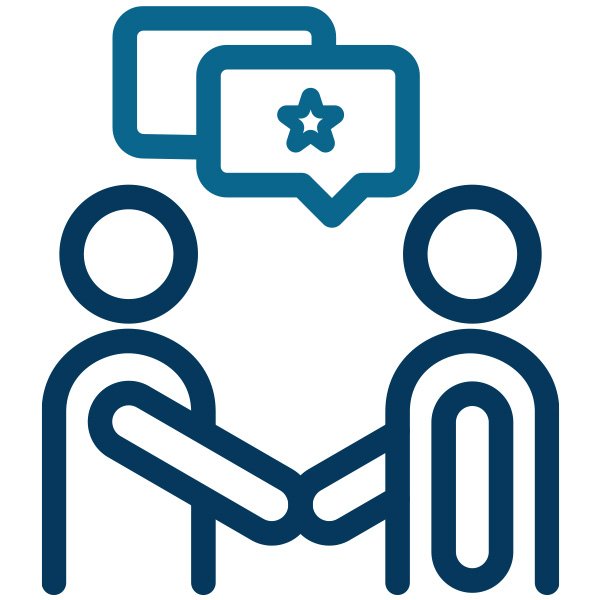ONLINE REPORT
Progressive Ideals,
Regressive Action
The Case for Addressing Disability Access in the Social Good Workplace
Image description: Five people are gathered around a table for a conversation. Two people have laptops. Four of the people are seated, while one is standing. The image is in black and white. Circling the image are abstract yellow shapes.
Executive Summary
Image description: Three people have a work conversation. Two people are standing, while one person is at a computer and uses a wheelchair. The image is in black and white. Circling the image are abstract shapes in yellow, green, and blue.
Progressive politics in the U.S. focuses on addressing unjust and unfair social conditions. But we are not immune from being unjust and unfair. Our work copies bad behavior and actions.
Ableist views, practices, and policies have normalized in our workplaces. Looking closely at them must be a priority. The United States (the U.S.) has slowly moved forward in disability public policy. But there has not been much careful thought of our own institutions.
Creating accessible workplaces is connected directly to justice and equity. As disabled writer and activist Shaun Bickley writes, “Depending on how disability is defined, we’re anywhere from 8.6% of people under [age] 65 to 20% of the U.S. population...Either way, we’re a demographic of significant size. So why don’t politicians and political organizations seem to know we exist?”
It may not be on purpose. But many liberal, Democratic, and progressive organizations work against their own values. These groups do not account for the needs of disabled employees. Often, disabled people are also ignored in advocacy and electoral work.
Ableism centers the experiences of non-disabled people. Ableism sees impairment as the issue, instead of the lack of accessibility as the problem. It is the stereotyping, prejudice, discrimination, and social oppression toward people with disabilities.
It also includes “othering’’ of disabled people. Othering happens in ideas, practices, institutions, and social relations. It includes actions that assume that being non-disabled is the norm. By othering, people with disabilities are marginalized – made to feel unimportant or powerless. Many employers and coworkers see disability supports as a “perk” instead of an expected policy of jobs.
Many people with disabilities in “progressive” workplaces have told their personal stories. When and how ableism is experienced in the workforce is also backed up by both quantitatively and qualitatively measured research and evidence. Meso Solutions conducted a review of this evidence in 2021.
There are significant harmful impacts on people with disabilities. Employers also see negative impacts, including financial costs. Statements of support are not enough. We cannot give a step-by-step checklist to wipe out ableism. Many ableist practices are rooted in capitalist standards of “productivity” and work. These practices harm both disabled and non-disabled people. Luckily, there is guidance to begin to counter these practices.
-
This requires ongoing effort to build clear and consistent spaces of anti-ableist and anti-oppressive management. The change must allow room for growth and accountability.
-
These include flexible time-off policies, work schedules, and remote work. There are many practices that are easy to implement. Ensure staff are aware of benefits. Encourage all staff to utilize those benefits, regardless of disability.
-
Disability and disease can begin at any stage of a person’s life. They may not be immediately diagnosable. Simple paths to accommodations include providing sick leave and short-term disability leave. These can support all staff and do not detract from workplaces.
-
“Campaign culture” exists across the progressive space. It includes demands to work more hours, produce more, and always be on the clock. This mindset pushes out and prevents people with disabilities from progressive jobs. It also creates a barrier for people with families and caretaker needs, people who are pregnant, those experiencing short- and long-term illnesses (including COVID-19), and others.
-
Workplaces that center people with disabilities have more positive outcomes. This includes better mental health, lower turnover rates, fewer sick days, and better productivity.
-
The law is not up to speed with accessibility research or lived experiences of those with disabilities. People with disabilities and researchers have shared data and examples to follow. These needs are broader than federal or state standards require.
-
Disability is not an isolated experience. It is often overlooked in “DEI” groups. Financial investment in this work can make major improvements. There are many resources that can be used to work on these problems.
-
To pursue equity and justice, our own organizations must engage genuinely with those most impacted. We must not turn “accessibility” into a buzzword. Non-disabled-led organizations and people can use this research (and more) to improve culture and conditions for everyone in their organizations.
They can especially support disabled workers.
Ableism in this report
Image description: Four people are standing and discussing something on a paper laying on a desk. The person on the left points to something on the paper. The image is in black and white. Circling the image are abstract shapes in yellow, green, and blue.
Communicating in long written reports is also an ableist practice. We took this approach to reach our target audience. They are used to getting information in this way.
But we tried to write in a way that is readable for many people. We should all seek to talk and write in plain language. Many reports we see are written at a college or higher reading level.
This report is written at a 9th to 10th grade reading level. It is still higher than we would like. You can read much more here: Plain Language Writing – An Essential Part of Accessibility¹.
SECTION I.
ABLEISM IN THE WORKPLACE
Image description: Three people are seated. The person in the middle holds a tablet, while the people on either side look toward the device. This image is in black and white. Circling the image are abstract shapes in yellow, green, blue, and white.
Employers embed ableist norms into the definition of work. This can show up in many ways. Especially when a right to equality is denied or someone downplays the effect of disability on one’s life.
People with disabilities are often seen as “nice” but not capable. It is a common theme of academic research and Meso’s own research. Microaggressions happen frequently. These include comments on bodies and abilities, assumptions about a person’s skills, and more.
Ableism and microaggressions often go together. Microaggressions are “commonplace verbal, behavioral, or environmental events” or “educational, financial, political, and policy systems ‘that convey hostile, negative, or derogatory insults toward persons of marginalized status directly due to that status.”² Extensive findings show that discrimination and bias happen through microaggressions and attitudes based on stereotypes. It is reflected in employers’ ableist practices and views. These result in barriers for working disabled people.
Why employers do not hire disabled people
According to researcher classification…
Twenty percent of employers displayed discrimination, prejudice, or reluctance to hire a person with disabilities.
Twenty-two percent of employers showed attitudes and stereotypes toward people with disabilities in their own firms.
Thirty-two percent of employers say it is difficult or very difficult to change supervisor and co-worker attitudes.
From: Is Disability Disabling in All Workplaces? Workplace Disparities and Corporate Culture³
These ableist views result in obvious outcomes. Disability visibility and justice are absent in progressive workplaces. There are few employees, volunteers, or constituents who identify as disabled. Many people feel compelled to hide their disabilities.
Disabled people are perceived as nice or “brave” but still less competent than their non-disabled peers. This results in day-to-day minimization of disabled peoples’ experiences and work. Over the long term, it results in less pay, less support, less training, and fewer promotions. There are very few senior leaders or elected officials who identify as disabled.⁴
Enforcing anti-ableist policies in training and practices can make these occurrences less frequent. But policies will likely never fully eliminate them. It will take creativity to imagine workplaces that are truly accessible.
Accommodations (or supports) and accessibility reveal many ableist behaviors. They are seen as an extra, special, and/or undeserved benefit. Supports are necessary for people with disabilities to do the job at the same level as other people who are equally qualified. For example, an employer might claim that allowing people with mobility disabilities to telework is an unreasonable accommodation. This denies the severity and complexity of mobility challenges. In this case, there is not much cost to the employer. But the employee’s ability to work becomes challenged. The employee is harmed. The employer is not.
One disabled woman described the difficulty of getting to work via public transit. Buses refuse to stop. Elevators are broken. Some subway stations are completely inaccessible. Taking public paratransit or private cabs is difficult. Those options have a limited number of accessible vans and qualified drivers. They are often late, need to pick up multiple passengers, make many stops, and are expensive to use.
A few accessibility standards are more commonly used, like video closed captions. Most practices are limited in scope. Many buildings still lack consistent physical accessibility for wheelchairs and other mobility equipment. Even when buildings have them, the supports can lead to physical isolation. Some buildings literally have backdoor-accessible entrances. Some people have to work in an office separate from colleagues due to lack of accessibility.
They also do not address the wide range of invisible disabilities. Something as simple as the lack of flexible work hours in a day can be a barrier for those with disabilities. Expecting that someone can work without breaks is an idea built by an ableist society. As the pandemic has shown, even potential solutions cause challenges. The use of video conferencing has led to so-called “zoom fatigue” for many workers.
“Invisible disabilities (as defined by the Invisible Disabilities Association) refer to symptoms such as ‘debilitating pain, fatigue, dizziness, cognitive dysfunctions, brain injuries, learning differences and mental health disorders, as well as hearing and vision impairments.”⁵
Non-disabled vs able-bodied
We use the terms “non-disabled” and “people without disabilities” interchangeably in this report. With a few exceptions pulled from quotes, we do not use the term “able-bodied.” That term further centers people without disabilities. It treats them as the norm. It also implies health or physical conditions that are not a fit to all people with disabilities. For example, someone can be deaf but also able-bodied. Like many identities, the use of these terms may evolve with time.
The Americans with Disabilities Act (ADA) and interpretations of the law
The ADA provides basic minimums for employers. It defines a person with a disability as a person who has a physical or mental impairment that substantially limits one or more major life activities. This includes people who have a record of an impairment, even if they are not currently having a limitation or relapse.
In 1990, Congress passed the ADA. The Act banned discrimination and failure to accommodate in employment, public spaces, and goverment services. A 2008 amendment expanded the scope of the law. The changes made were intended to broaden the definition of disability. It had been narrowed through judicial decisions. Workplaces should strive to go beyond the protections provided by the ADA. As with many laws, the ADA does not meet all the needs of the community. As well, many organizations are legally exempt.
Identity-first vs. person-first language
In our research, we interacted with people who preferred using person-first language. We also had people who preferred to use identity-first language when discussing disability. We recognize that the disability community is large and diverse. Both of these approaches are valid. We use identify-first and person-first language interchangeably in this report.
Accommodations for disabled people
Workplace accommodation (support) is a means of ensuring equal opportunity employment for people with disabilities. This can be many different things. For example, it can mean flexibility in a work schedule. Or it can be changes in commutes to and from work. But supports are put in place only once someone has asked for it. Due to understandable internalized ableism or fear of punishment, many people will not disclose a disability. They may also wait until a situation is dire. It makes it hard to address needs at work.
WHAT EMPLOYERS ARE INCLUDED IN THE ADA?
Job discrimination against disabled people is illegal if done by:
Employment agencies
State and local governments
Labor organizations
Private employers with 15 or more employees
Labor management committees
Many workplaces do not fit into these categories. We urge employers to comply with the spirit of the ADA and other disability laws.
“The ADA is based on the medical model, which places the onus on the disabled individual to demand access rather than requiring universal design. This creates the impression that individuals who receive accommodations are recipients of special treatment or welfare.”⁶
It is not hard to find examples where this ableism is clear. Many instances are made worse in a pandemic. Guttmacher Institute is a well-known research and policy firm working to advance sexual and reproductive rights in the U.S. Staff were told to return to the office in early summer of 2021. COVID-19 continued to spread with the Delta variant. Anyone who asked to work from home for medical reasons had a third party look into requests. The third party would decide to approve or deny the request. Workers could be denied their own health needs and medical advice. This could lead to job termination. Workers were forced to “prove” their medical needs in an unacceptable way.
Ironically, the pandemic has also made many people aware of the challenges to disability records. Many experience “long covid” symptoms, which are difficult to diagnose and prove. Even getting a COVID-19 test has, at times, been nearly impossible. Disabled people can face these issues every day.
Experiences of people with disabilities are as vast and unique as any other demographic in the United States.⁷ We cannot cover the full spectrum of disabilities and workplace needs. Instead, we can focus on making safer spaces for people who are doing professional work that is usually associated with office work, including politics, organizing, and advocacy.
The history of the treatment of people with disabilities and the advocacy work done to improve that treatment also goes beyond the scope of this report. We highly encourage finding other first-person stories and other readings beyond this report, with first-person stories, some of which are listed in the appendix.
WHAT DOES ABLEISM LOOK LIKE?
Ableism can be defined as the stereotyping, prejudice, discrimination, and social oppression toward people with disabilities. But ableism can be experienced in many ways. Below are some examples.
Ableism can manifest in judgment of people with disabilities...
Feeling or expressing pity for disabled people
Some examples of pity language that are often used include: suffering from; afflicted by; stricken with; and victim of.
Assuming that a person with a physical disability has an intellectual disability or vice versa
Claiming to understand the experience of a person with a disability
Telling a person with a disability that they look “too good,” “too young,” or “too pretty” to be disabled; suggesting that disability should look a particular way
...or more explicitly in interactions.
Denying a disabled person their privacy
Asking questions about the disability or other private questions about the effects of the disability on the person’s life
For example, “What happened to you?”
Offering medical advice without being asked
Violating physical boundaries, including touching assistive devices
Commenting on or asking about someone’s accommodations
Feeling or expressing jealousy or anger at accommodations – seeing accommodations as an extra, special, and/or undeserved benefit
For example, “Why does she get that and we don’t?”
One disabled woman worked part-time to accommodate her physical therapy schedule. She told this report’s authors: “People would say, ’’Oh I wish I could have the day off.’”
Ableism can be seen in a lack of understanding about individuals with disabilities...
Seeing disability as a weakness and a negative way of living; assuming that being non-disabled is a preferred and positive experience
Speaking down to disabled people as if they are children or incompetant
Feeling a sense of entitlement over disabled people; feeling the right to pass judgment on them
...and can even look like good intentions.
Seeing a person with a disability as inspirational just for living their lives
One anonymous research participant stated that when using a necessary accommodation such as a motorized shopping cart: “Strangers either won’t look at me or they are like, ‘Hey look at you shopping by yourself!’ … I’ll shop in my wheelchair, and it’s so different. Like suddenly people are so impressed with all my ingenuity.”
Insisting on helping without consent or after assistance has been refused
Ableism can be an oversight of accommodations in the workplace.
Claiming your building is accessible when, in fact, it is not; thereby getting benefits from claiming accessibility without providing access
Building websites that are unusable for people with visual disabilities
Lack of closed captions, audio descriptions, and sign language translators in videos or trainings
Using venues that cannot be easily entered or navigated
Separating disabled workers from non-disabled workers in an office; for example, having mobility-accessible offices in a different part of the office
SECTION II.
OUTCOMES OF ABLEISM
Image description: A person uses a glucose testing machine on their fingertip to check their blood sugar. The image is in black and white. Circling the image are abstract shapes in yellow, red, green, and blue.
Ableism in the workplace
Research shows many negative experiences of people with disabilities across the workforce. People with disabilities:
Lower pay
Experience lower pay, in part due to impairments and health problems that limit productivity. It is also because of employer discrimination and other attitude and physical barriers. This also includes lack of accommodations and training.
Fewer benefits
Receive fewer benefits such as employer-provided health insurance and pension plans
Lower positions
Are more likely to be in production and service jobs. Are less likely to work in professional, technical, or managerial jobs.
Non-standard jobs
Are more likely to be in part-time, temporary, and other non-standard jobs. These jobs often provide low pay and few or no benefits. People with disabilities are not more likely to work in jobs with flexible schedules.
Lower job security
Experience lower job security and higher rates of job loss.
Lower satisfaction
Experience lower levels of job satisfaction.
Less rewarding
Are less likely to be in jobs considered ‘‘economically and psychologically rewarding.’’
Shorter tenure
Have shorter tenure on average than non-disabled workers.
Lower compensation
Receive much lower total compensation as compared to the market value.
Discrimination
Report being more closely watched. Have lower levels of participation in job and department decisions.
Employees with disabilities felt less valued by employers than their peers without disabilities. This assessment was not surprising. Our review of research on disability in the workplace found several areas where disabled workers experienced different treatment. One study of disabled and non-disabled peers found that people with disabilities were less likely to receive formal, company-sponsored training in the last year. Workers with disabilities also received less informal training and mentoring from coworkers. This resulted in fewer promotions and less integration in the workplace.
Underneath these concrete findings is the regular treatment of disabled colleagues as “nice” but “incapable.” This results in unequal treatment. The impact of these actions are shown to have long-term effects.
To address ableism in workplaces, we must recognize the complex ways that identities and social positioning intersect. These create unique experiences of marginalization. The scholar who coined the term intersectionality, Kimberlé Crenshaw, writes, “Many of the experiences Black women face are not subsumed within the traditional boundaries of race or gender discrimination as these boundaries are currently understood, and that the intersection of racism and sexism factors into Black women’s lives in ways that cannot be captured wholly by looking at the race or gender dimensions of those experiences separately.”
Unfortunately, there is limited formal research on the ways various social identities and experiences of oppression intersect with disability. While thinking about disability inclusion in the workplace, accept that more than just ableism is present. Accept the unique and hard ways that other forms of marginalization and social inequity can affect employees with disabilities. People from multiple oppressed groups may run into more barriers in medical and workplace settings than a disabled person without those marginalized identities.
Intersectionality of race and disability on employment
According to a 2020 study, disabled people of color experience higher rates of joblessness than disabled white people.
Rates of people without jobs by race: 11.6 percent for white people, 15.7 percent for Asian people, 16.3 percent for Black people, and 16.8 percent for Hispanic people.
SECTION III.
IMPACTS ON WORKPLACES
AND PROGRESSIVE ORGANIZATIONS
Image description: Two people are working together. Both are wearing hijabs. The person on the left has a pen and notebook, while the person on the right is typing at a laptop. The image is in black and white. Circling the image are abstract shapes in yellow, green, and blue.
Employers and funders cannot expect to make progressive changes in the world and ignore internal culture. Culture can shut people with disabilities out of the workforce. Ableist practices and policies can badly impact organizations. In the end, these can have financial consequences, too. Financial issues limit the potential for real-world change.
Groups benefit when workplaces offer a supportive environment for disabled and non-disabled employees. Advantages include retention of quality employees, increased output, and better cash flow. It also avoids costs of hiring and training of new employees.
Policies and practices can support improved organization culture and climate. They can help employees feel valued and recognized. There are also social benefits of creating a positive work culture. It brings high morale. That can lead to higher capacity, creative tactics, and innovative strategies. Creativity and innovation can help lead to progressive goals.
For disabled people in supportive workplaces, experiences include higher loyalty, dependability, capacity, and increased feelings of physical and mental safety. Focusing on disabled people at work meets values of social and economic equity and diversity.
Supportive workplaces create a quiet competitive lead. Truly diverse workplaces are shown to increase creativity. Groups that really include people with disabilities will see value from more views and experiences.
We do not usually think of competitive value within the progressive space. And there are important challenges to production and output. Focusing on production can create exploitive, capitalist goals. But it can be helpful to consider the potential for increased impact of programs. We can foresee big changes led by progressive values.
Supervisors in progressive organizations often receive limited support to become strong managers and hirers. Managers rarely receive guidance to address disability in their teams. They get generic, blanket anti-bias training only once a year. This lack of training can impact workers with disabilities. It can cause harm. Organizations lose out, too.
Funders also reinforce ableism. Funding is often assigned for specific programs and outcomes. Funders ask for metrics to grow. Constant growth forces organizations to increase production. It can put hard-to-reach standards on employees. This means that few people are able to meet the work expectations. People with disabilities are capable of quality work. But it may be difficult to work under these demands.
Leaders can have good intent. Without workplace accountability, though, both they and senior staff can enforce ableist practices. We see few disabled fundraisers or funders. In the past, fundraising valued face-to-face time. This is not always easy for disabled people. The pandemic has forced many fundraising efforts to adjust their practices. We may see more disabled donors and fundraisers in the future. However, It will likely take a long time to correct for the lack of investment in this area. Until then, organizations will continue to miss out on valuable funding.
“Bad bosses” are a major reason that employees quit. Overall work setting is close behind. Employee retention can save organizations and companies. It can cost thousands or tens of thousands of dollars in lost time. Hiring an early-career employee can take 50+ hours of staff time to complete. A senior or executive hire can absorb hundreds of hours of staff time. Onboarding and training costs hundreds more. It takes most workers several months to be on their own and good at their work.
Workers from all backgrounds now demand healthier, safer workplaces more than ever before. Workplace culture is about more than perks or how outgoing people are. Organizations steeped in ableism likely have bad work cultures. They may promote overwork to the point of exploitation. They may value perfectionism. They may encourage ineffective or harmful program expectations and outcomes. It is critical to continue to evolve with staff needs. To attract disabled and non-disabled people, employers have to examine their policies. Otherwise, they should expect to see staff quit and expect job seekers to be uninterested.
SECTION IV.
RECOMMENDATIONS AND SOLUTIONS
Image description: Two people are seated at a table with a laptop, drinks, and papers. The two people are smiling and giving one another a high-five. The image is in black and white. Circling the image are abstract shapes in yellow, green, red, and blue.
Research shows many challenges in the workplace. It also gives guidance and reasonable solutions. This report used quantitative research and community stories. Like all research-based guidance, there are limitations and gaps. Almost no research talked about intersectional identities in the workplace. These include gender, race, age, sexuality, and more. Any number of experiences could change needs and approaches. Recommendations and “best practices” are not a checklist for equity. View these as a starting point. Culture changes as a team changes. We will continue to learn from research and stories. Employers should get feedback on efforts and evolve.
“Typical burnout movement organizations that are, maybe, starting to try a little bit to not run their workers into the ground ‘til they get sick…[but] not actually using a model of sustainability that comes from disability justice! It’s doing the same [thing] movements have insisted on for years – which pushes out parents, broke folks, and disabled folks… but tacks on a little self-care.”⁸
A justice climate in the workplace
Progressives fight for justice on a host of issues. We must also pursue a justice climate in the workplace. This can affect the relationship between employers and employees. There are negative outcomes for all employees (such as turnover, capacity, etc.) when a workplace is seen as unjust. Turnover rates are high among those with disabilities.
Creating a work justice climate both encourages and normalizes disability. At the same time, it reduces the potential of negative effects for employees who share their disability. Researchers also suggest that when employees feel comfortable talking about their disability or illness, it can serve as an informal indicator of a supportive workplace environment.
There are a few aspects of a justice climate in a workplace. These include:
-
Directly working on inequities. (for example: pay differences, strict work standards, and access to accommodations)
-
Policies and procedures, like how requests for accommodations are handled.
-
The extent staff are treated with dignity and respect.
The ADA and other laws set basic demands. But they do not go far enough. Progressive organizations often copy generic, corporate practices. These policies are meant to limit litigation risk to the employer and maximize shareholder and leadership incomes. They usually discriminate against disabled people, even if they don’t mean to. There is not proof that the corporate, capitalist model works for disabled people. It does not increase productivity or income. And it does not support mission-oriented outcomes.
Creating a justice climate requires culture, policy, and goal changes. These may be unique to each organization.
A safer space for accommodation needs (more below).
Better standard work demands. Rethink the idea that there is one way to successfully work.
Counteract white supremacist work culture.⁹ This can improve work for disabled people as well.
Transparent pay, benefits, and resources. There is not one perfect way to achieve pay equity. Thoughtfulness and transparency are critical pieces.
Consistent hiring processes. Craft anti-ableist accountability in hiring. Set organization-wide demands for hiring managers and senior staff.
Positive and supportive supervisor relationships and accountability.¹⁰ Failing to invest in management practices leads to long-term problems. It can create ableist practices (and legal issues).
Supportive workplaces that promote the success of employees with disabilities.
Clear harassment, retaliation, and reporting guidelines with an intersectional and anti-ableist lens. Enforce accountability when bad behavior happens.
Clear and accessible benefits and resources. This includes health insurance, professional development, home office funds, and more.
Proactive ableist review and approval for space usage. For example, finding out if an office or event space is truly accessible for mobility equipment.
High-quality disability awareness training. This should be part of justice-oriented equity efforts. These efforts must be long term, not a single training.
Inclusive public materials. Follow anti-ableist design and writing principles.¹¹ Center disabled people from the start – not as an afterthought.
More! Get creative. Work with your team. Listen to disabled activists. This list will grow and change.
Flexible and kind practices
Policy change will not solve accessibility and equity challenges. But they can reinforce “good behaviors.” Research stresses the value of flexibility at work. Remote work, flexible work hours, and unlimited sick leave can create better overall outcomes.
Allowing and trusting employees to make decisions for their own health is a critical and immediate need. It allows people to manage their day, energy, and needs. Disabled people and activists have advocated for these policies for a long time. They are helpful for a wide range of disabilities. They can be helpful for non-disabled staff as well.
Flexibility has very little negative impact on the employee or employer. It often results in fewer sick days and higher capacity. It can even save money on office space needs. But if it is not adapted well, a remote or “hybrid” work space can exclude disabled staff. Meeting and communications can give priority to people who are there in person.
Work policy recommendations include:
Flexible time off. Including “no excuse needed”¹² sick leave.
Flexible schedules: Allow staff to work the times they are most energetic for work.
Remote work: This can provide huge health and productivity benefits.
Increased paid time off: An ability to take time for rest has health benefits for all workers. It also lets people take short-term medical leave.
Mental health as sick leave: Paid sick leave policies must explicitly include therapy, mental health treatment, and mental health days.
Clear and easy accommodation requests (more below).
Accountability practices: Clear ways to report workplace harassment and discrimination. These should include an expectation to engage with an employee from a premise of believing the harmed person.
Terms to avoid
When a person is sharing their disability, limit terms such as “disclosure” and “declaration.” These terms imply that disability is a secret or shameful. It can increase stigmatization of disability in the workplace.
Easy access to accommodations
We can never predict all needs, because they vary by individual. Meeting needs requires a comfortable work space for employees. It is one where people can share information about their disability and ask for what they need. Researchers¹³ found that disabled people are often concerned about experiencing negative treatment after sharing information about a disability. This fear is justified and grounded in reality.
Almost 25% of survey respondents in one study faced long-term negative impacts from sharing disability information with their employer. Disparate treatment includes:
Not being hired due to sharing during an interview process
Lowered expectations from supervisors
Perceived favoritism by coworkers and colleagues
Increased likelihood of termination
Employers should:
Ease medical and other documentation requirements
Provide access to short-term disability, in addition to leave supplemented by state or federal government
Proactively support all employees’ mental health
Provide mental health paid days off, and support access to therapy
Simply ask people what they need.
One person described being repeatedly denied sick leave needs. Their doctor’s notes changed over time with the employee’s health needs. The organization was rigid and rejected the notes and request. The person was finally pushed out of their job.
Requiring medical proof adds stress on people experiencing disability or illness. Most human resources workers are not equipped to understand medical diagnoses. Employees should not need to share until when and if they choose to. Providing proof is demeaning, unethical, and an invasion of privacy. Short sick leave requests without a doctor’s note should be more than sufficient.
Other policies can also present barriers. Waiting periods for health insurance benefits mean new employees have to choose either to pay out-of-pocket costs or go without health insurance. Waiting periods add challenges to get doctor’s notes for accommodation requests.
Accommodations impact
Accommodations or supports have a perceived financial or time investment. But the reverse is shown to be true. Most cost little or nothing. Large-scale studies found that supports led to:
→ Improved employee capacity
→ Positive returns on time and energy
→ Better attendance
→ Better attitudes
→ Improved coworker
interaction and attitudes
→ Lower stress levels
→ Better overall organizational
morale and employee
satisfaction¹⁴
→ Decrease in medical usage and clinic visits
Staff training and accountability
Equity training can be used to increase representation and inclusion of people with disabilities and other marginalized groups. Mentorship programs and training have been used to support other historically underrepresented groups. However, education or mentoring must be used alongside other efforts.
Mentoring and training alone will not change underlying problems. Standalone bias awareness training can backfire if it is not backed up by other actions over time. Individual bosses can make or break the experience for disabled workers. The programming should address systemic bias and discrimination within policies and structures.
For example, end-of-year reviews of managers should have anti-oppression and anti-bias metrics. For managers, 360 reviews allow direct reports, peers, and other leaders to give feedback as well. Reviews can identify managers taking oppressive actions, whether on purpose or not. But reviews will fail if there is no accountability for poor behavior. Biased and oppressive behavior must be treated as seriously as if a manager was failing to deliver on other work. That could mean issuing a warning, developing a performance improvement plan (PIP), or ultimately firing an individual.
Welcome people with disabilities
Ableism can show up in many small ways. It can make it impossible for disabled workers to thrive. Better hiring steps can contribute to safer workplaces. But hiring is one of the last steps to take.
When faced with a problem, many organizations engage in reactionary hiring solutions. They do so without examining the organization’s overall culture, structures, and practices. Simply hiring more people from an oppressed community can tokenize people. It can lead to further harm, as well as poor organizational outcomes.
Most organizations claim to be accessible and welcoming. But they often fail to create workplaces that meet those ideals. One disabled worker shared their challenges with part of a job application. They had to complete a written task. It was a struggle due to time and format limits. They were not comfortable asking for accommodation. It felt like a risk to potential employment. In the end, the person was hired and has felt welcomed. But that is often not the case.
Fair hiring practices
Conduct a critical review of hiring practices. Ensure training on the subtle ways that ableism impacts decision-making throughout the hiring process.
Offer accommodations from the start (e.g. phone-only interviews and time extensions). Flexibility in the interview process allows for more accessibility to jobs.
Legally, an employer cannot ask a job applicant about their disability status. Disability and accommodation needs cannot be a part of the hiring decision.
Once an offer is made, accommodations can be discussed. Accommodations cannot be considered part of a compensation package. It is a separate, legal requirement. If an accommodation need truly cannot be met, the offer can be withdrawn.
Organizations can choose to prioritize hiring qualified individuals with disabilities over other qualified applicants without a disability.
An applicant may choose to share their disability during the interview process. It is the employer’s duty to ensure an anti-ableist hiring process.
CONCLUSION.
THE WORLD WE ENVISION
Image description: Two people are discussing work together. The person on the left sits and holds a piece of paper. The person on the right uses a wheelchair and is presenting at a laptop. The image is in black and white. Circling the image are abstract shapes in yellow and blue.
We aspire to live in a world where disability and access are part of a just future. One cannot exist without the other. This work has to be intentional and thoughtful. It will take much more than an elevator-accessible building. Making and keeping all spaces accessible will set up society for a necessary shift. This will require people to question current toxic work environments and cultures.
Author Rebekah Taussig argues, “There’s a contradiction between saying a workplace is inclusive even as it participates in the larger cultural values that celebrate everything a disabled body is not.”¹⁵
Instances include:
Failing to foster an inclusive work environment.
Focusing on being a “well-oiled machine.”
Excluding people who do not work “well” according to corporate standards.
Praising and promoting people solely on corporate-oriented outcomes.
These set us up to believe that anything outside of those measures is not worthy of celebration.
As Tausig notes, “When you applaud your employees only for arbitrary measurements of work – arriving early, leaving late, never taking sick days or time off… – when you always push for more – production, happy hours, publications…meetings, tasks, involvement… – you do not demonstrate an appreciation for those who have a need, who say no, enforce boundaries, or require flexibility – the very stuff of accommodations masked under different names.”
We must focus on access for everyone. Creating workplaces and missions around this ideal is a vital part of progressive values. After tasting accessibility, inaccessible communities will feel lacking. This is exactly the push we need.
THANK YOU AND BIOS.
Image description: Two people communicate using American sign language. The person on the left smiles and points to their thumb with all fingers extended. The person on the right crosses two fingers on either hand. The image is in black and white. Circling the image are abstract shapes in yellow, green, and white.
THANK YOU
This report was written and designed with and by, but not only for, disabled people. We are incredibly grateful to the many people who shared their stories, experiences, and wisdom – disabled activists, researchers, writers, and workers alike. We are particularly grateful to the hundreds – if not thousands – of unknown people who contributed to the academic research utilized for this report.
WHO IS MESO SOLUTIONS
Meso (pronounced MEH-zo) Solutions is a small firm that focuses on the hiring process for progressive groups who share our values. Equity is at our core. We believe that real progressive change is the result of thousands of people working hard every day. Those people must reflect the people closest to the problems.
As a workplace, Meso is committed to continuous improvement of our environment and culture. We strive for a transparent and communicative workplace that prioritizes well-being as individuals and as a group. We, by no means, claim to be a perfect, anti-ableist workplace. But we hope to continue to make changes in pursuit of that goal. You can learn more about us on our website at MesoSolutions.co.
REPORT TEAM
Primary researcher: L (she/her)
L completed a master’s degree with a focus in qualitative research methods and all coursework in a quantitative methods and political psychology PhD program. She holds a deep understanding of disability in the workplace from both personal experience and professional research. She previously worked in academia and progressive and liberal organizations and consulted for Meso Solutions as the primary researcher for this report.
At L’s request, we are unable to provide her full name and background information. This report is insufficient to address the host of systemic challenges presented to disabled people. But giving personal information could cause legal and financial problems. Suffice it to say, we are infinitely grateful for her leadership and research on this project. This report would not exist without L’s work.
Co-Authors:
Lena Tom (she/her) is the President and Founder of Meso Solutions and its sister site Progressive Data Jobs. With 20+ years of experience in nonprofits, political campaigns, labor unions, and more, she brings a depth of knowledge on what helps an organization thrive. She spent more than 10 years as a data and analytics practitioner. Lena believes in the importance and value of data to tell a story, while also recognizing the limitations of traditional research methods. Lena is a proud granddaughter of Chinese immigrants, a preacher’s kid, an artist, and also lives with chronic pain.
Temi Akande (she/her) joined the Meso Solutions team in March 2020. Temi holds a B.A. in Political Science with a minor in International Studies from the University of Illinois at Chicago. She has honed in on her love for connecting people to resources that can help open doors for them. A lover of all things progressive politics, Temi prides herself on being an advocate for all marginalized communities, but especially Black women. From a young age, Temi was vocal about wanting to be the change she wants to see in the world. Her goal is to thrive in spaces that are not only diverse but inclusive.
Darin J. Dorsey (he/him), formerly Vice President of Meso, is committed to working with organizations to ensure that their external values are reflected in their internal policies and practices. He believes that creating joyful and liberating workplaces is the first step that organizations can take in their work to address inequities. He recently founded Rooting Movements.
Designer: Elsa Coussy (they/them)
Elsa is a disabled graphic designer and creative director of Sephardic Moroccan descent from France. They have a graphic studio and work to empower the voices of their communities (LGBTQ+, Jews, Autistics) to spread awareness about inclusion, disability rights, and the beauty of tajines.
Marketing Support team - Buoy Integrated Marketing
Nicole Carroll (she/her), communications strategist
Cristofer Valle (he/him), designer
Ashley Whitehurst (she/her), senior communications strategist
Gretchen Wieland (she/her), owner
Reviewers
The following provided critical review and feedback on the report during various drafts:
Shaun Bickley (they/them), disability justice writer and activist
Naima Lowe (she/her), artist and independent consultant
Nirmal Mankani (he/him), analytics consultant
Josh Rosmarin (he/him), researcher and funder advisor
Meso Solutions team
Destinee Gomez-Fernando (she/her), Search Associate
Lara Haddadin (she/her), Senior Search Associate
Santos Moreno (he/him), Search Associate
Molly Salazar (she/her), Project Associate
Nnedi Stephens (they/she), Vice President, Search
Photo credits
FURTHER READING AND REFERENCES
Image description: Two people discuss something on a piece of paper. The person on the left is seated and has a laptop in their lap and holds the paper. The person on the right uses a wheelchair. The image is in black and white. Circling the image are abstract shapes in yellow, green, and blue.
We have provided a list of readings we recommend. These include short online articles, books, and academic articles. These helped inform our own research. As with any topic, this list is incomplete. We encourage you to continue to explore other resources and stories.
Short articles
by Tema Okun . dRworks . www.dismantlingracism.org
Plain Language Writing — An Essential Part Of Accessibility
Andrew Pulrang
Universal design, trauma-informed care, and accessibility applied
Progressives have failed disabled people
Books
Care work: Dreaming Disability Justice
by (Vancouver: arsenal pulp press, 2018)
Demystifying Disability: What to Know, What to Say, and How to be an Ally
by Emily Ladau (Ten Speed Press, 2021)
A Disability History of the United States
by Kim E. Nielsen (Beacon Press, 2012)
Sitting Pretty: The View from My Ordinary Resilient Disabled Body
by Rebekah Taussig (HarperCollins Publishers, 2021)
What Doesn’t Kill You: A Life with Chronic Illness - Lessons from a Body in Revolt
by Tessa Miller, (Henry Holt and Company, 2021)
Recommended Academic Articles
“Perspectives on Disability Disclosure: The Importance of Employer Practices and Workplace Climate”
by Von Schrader, S., Malzer, V., & Bruyère, S. in Employee Responsibilities and Rights Journal, 26(4), 237-255, 2014
“Is Disability Disabling in all Workplaces? Workplace Disparities and Corporate Culture”
by Schur, L., Kruse, D., Blasi, J., & Blanck, P. in Industrial Relations: A Journal of Economy and Society, 48(3), 381-410, 2009
“The Experiences of Microaggressions Against Women with Visible and Invisible Disabilities”
by Olkin, R., Hayward, H. S., Abbene, M. S., & VanHeel, G. in Journal of Social Issues, 75(3), 757-785, 2019 (permanent, stable link to paid version https://doi.org/10.1111/josi.12342)
Additional Resources
EEOC.gov
Depression, PTSD, & Other Mental Health Conditions in the Workplace:
Your Legal Rights
How to File a Charge of Employment Discrimination
Your Employment Rights as an Individual with a Disability
Enforcement Guidance on Reasonable Accommodation and Undue Hardship under the ADA
The 411 on Disability Disclosure
Employment Accommodations Explained
My Body Doesn’t Oppress Me, Society Does
Disability in an Ableist World
Showing up for racial justice (SURJ)
10 Ways to Make Your Organization More Inclusive of People with Disabilities
References
Pulrang, A. (2020, October 23). “Plain language writing - an essential part of accessibility.” Forbes. Retrieved May 4, 2022, from https://www.forbes.com/sites/andrewpulrang/2020/10/22/plain-language-writing---an-essential-part-of-accessibility/?sh=83047fe7935a.
Sue, D. W., Capodilupo, C. M., Torino, G. C., Bucceri, J. M., Holder, A. M., Nadal, K. L., & Esquilin, M. (2007). “Racial Microaggressions in Everyday Life: Implications for Clinical Practice.” The American Psychologist, 62(4), 271–286. https://doi.org/10.1037/0003-066X.62.4.271.
Schur, L., Kruse, D., Blasi, J., & Blanck, P. (2009). “Is Disability Disabling in All Workplaces? Workplace Disparities and Corporate Culture.” Industrial Relations: A Journal of Economy & Society, 48(3), 381–410. https://doi.org/10.1111/j.1468-232X.2009.00565.x
Bruyère, Susanne M. (2000) “Civil Rights and Employment Issues of Disability Policy.” Journal of Disability Policy Studies, vol. 11, no. 1, 18–28. doi:10.1177/104420730001100108.
Syma, C. (2019). Invisible Disabilities: Perceptions and Barriers to Reasonable Accommodations in the Workplace. Library Management, 40(1/2), 113–120.
These recommendations may be utilized in other countries, but our research was focused on the United States, its laws, and cultural norms.
Bogart, K. R., & Dunn, D. S. (2019). “Ableism Special Issue Introduction.” Journal of Social Issues, 75(3), 650–664.
Piepzna-Samarasinha, Leah Lakshmi (2021). Care Work: Dreaming Disability Justice. Arsenal Pulp Press.
Okun, T., & Jones, K. (2016). “Dismantling Racism: A Workbook for Social Change Groups.” https://www.dismantlingracism.org
Through supervisor training, accountability, and reinforcement over time.
Forbes (2022).
No requirement for medical proof for standard sick leave.
von Schrader, S., Malzer, V. & Bruyère, S. (2014). “Perspectives on Disability Disclosure: The Importance of Employer Practices and Workplace Climate.” Employ Respons Rights J 26, 237–255. https://doi.org/10.1007/s10672-013-9227-9.
Solovieva, Tatiana & Dowler, Denetta & Walls, Richard. (2011). “Employer Benefits from Making Workplace Accommodations.” Disability and Health Journal. 4, 39-45. 10.1016/j.dhjo.2010.03.001.
Taussig, Rebekah (2021). Sitting Pretty the View from My Ordinary Resilient Disabled Body. HarperOne.












































